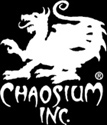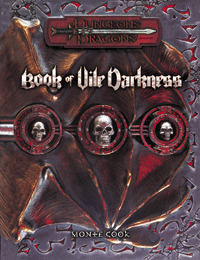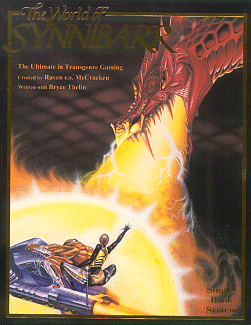
Call of Cthulhu is a horror fiction role-playing game based on H. P. Lovecraft's story of the same name and the associated Cthulhu Mythos. The game, often abbreviated as CoC, is published by Chaosium; it was first released in 1981 and is in its seventh edition, with licensed foreign language editions available as well. Its game system is based on Chaosium's Basic Role-Playing (BRP) with additions for the horror genre. These include special rules for sanity and luck.

Chaosium Inc. is a publisher of tabletop role-playing games established by Greg Stafford in 1975. Chaosium's major titles include Call of Cthulhu, based on the horror fiction stories of H. P. Lovecraft, RuneQuest Glorantha, Pendragon, based on Thomas Mallory's Le Morte d'Arthur, and 7th Sea, "swashbuckling and sorcery" set in a fantasy 17th century Europe.

The Norns are deities in Norse mythology responsible for shaping the course of human destinies.

RuneQuest is a fantasy tabletop role-playing game originally designed by Steve Perrin, Ray Turney, Steve Henderson, and Warren James, and set in Greg Stafford's mythical world of Glorantha. It was first published in 1978 by The Chaosium. Beginning in 1984, publication passed between a number of companies, including Avalon Hill, Mongoose Publishing, and The Design Mechanism, before finally returning to Chaosium in 2016. RuneQuest is notable for its system, designed around percentile dice and an early implementation of skill rules, which became the basis for numerous other games. There have been several editions of the game.

Dragon is one of the two official magazines for source material for the Dungeons & Dragons role-playing game and associated products, along with Dungeon.
Open gaming is a movement within the tabletop role-playing game (RPG) industry with superficial similarities to the open source software movement. The key aspect is that copyright holders license their works under public copyright licenses that permit others to make copies or create derivative works of the game.

Keith Baker is an American game designer and fantasy novel author. In addition to working with Wizards of the Coast on the creation of Eberron, he has also contributed material for Goodman Games, Paizo Publishing and Green Ronin Publishing. In 2014, Baker and Jennifer Ellis co-founded the indie tabletop game company Twogether Studios.

Fate is a generic role-playing game system based on the Fudge gaming system. It has no fixed setting, traits, or genre and is customizable. It is designed to offer minimal obstruction to role-playing by assuming players want to make fewer dice rolls.
Ragnarök is a series of events in Norse mythology resulting in the fiery destruction and fertile rebirth of the world.

Book of Vile Darkness is an optional supplemental sourcebook for the 3rd edition of the role-playing game Dungeons & Dragons. The book was written by Monte Cook and published by Wizards of the Coast on October 1, 2002. Described as a "detailed look at the nature of evil," it was the first Dungeons & Dragons book labelled for mature audiences.
The Norse mythology, preserved ancient Icelandic texts such as the Poetic Edda, the Prose Edda, and other lays and sagas, was little known outside Scandinavia until the 19th century. With the widespread publication of Norse myths and legends at this time, references to the Norse gods and heroes spread into European literary culture, especially in Scandinavia, Germany, and Britain. In the later 20th century, references to Norse mythology became common in science fiction and fantasy literature, role-playing games, and eventually other cultural products such as Japanese animation. Storytelling was an important aspect of Norse mythology and centuries later, with the rediscovery of the myth, Norse mythology once again relies on the impacts of storytelling to spread its agenda.
Paizo Inc. is an American role-playing game publishing company based in Redmond, Washington, best known for the tabletop role-playing games Pathfinder and Starfinder. The company's name is derived from the Greek word παίζωpaizō, which means 'I play' or 'to play'. Paizo also runs an online retail store selling role-playing games board games, comic books, toys, clothing, accessories and other products, as well as an Internet forum community.

The World of Synnibarr was a multi-genre role-playing game published by Wonderworld Press and written by Raven c.s. McCracken. A second edition of the game, co-written by Bryce Thelin, was published in 1993. Historically, the 1st edition was noted largely for its complex design. However, the 3rd edition revamped the mechanics and has evolved into an "amazing" game.

A diceless role-playing game is a tabletop role-playing game (TTRPG) which is not based on chance because it does not use randomizers to determine the outcome of events. The style of game is known as "diceless" because most TTRPGs use dice as a randomizer. However, some games use other randomizers such as playing cards instead of dice, and these are not considered "diceless."

Goodman Games is an American game publisher best known for the Dungeon Crawl Classics series of adventure modules and role-playing game, its science fiction offshoot Mutant Crawl Classics, and Original Adventures Reincarnated, a line of updated, annotated, and expanded republications of classic RPG adventures and supplements, mostly from TSR, Inc.'s Advanced Dungeons & Dragons. Additionally, Goodman Games produces RPGs using versions of the DCC rules for Fritz Leiber's Lankhmar and Jack Vance's Dying Earth settings, under license. The company has also produced licensed adventures for Wicked Fantasy Factory, Judges Guild, Xcrawl, Iron Heroes, Castles and Crusades, and Death Dealer.
Evil Hat Productions is a company that produces role-playing games and other tabletop games. They are best known for the free indie RPG system Fate, Blades in the Dark, and Thirsty Sword Lesbians, all of which have won multiple awards.

Norse, Nordic, or Scandinavian mythology, is the body of myths belonging to the North Germanic peoples, stemming from Old Norse religion and continuing after the Christianization of Scandinavia as the Nordic folklore of the modern period. The northernmost extension of Germanic mythology and stemming from Proto-Germanic folklore, Norse mythology consists of tales of various deities, beings, and heroes derived from numerous sources from both before and after the pagan period, including medieval manuscripts, archaeological representations, and folk tradition. The source texts mention numerous gods such as the thunder-god Thor, the raven-flanked god Odin, the goddess Freyja, and numerous other deities.
Free RPG Day is an annual promotional event by the tabletop role-playing game industry. The event rules are fairly simple: participating publishers provide special free copies of games to participating game stores; the game store agrees to provide one free game to any person who requests a free game on Free RPG Day.

Kobold Press, also known as Open Design, is an American game company that produces role-playing games and game supplements.

The Starfinder Roleplaying Game is a science-fiction/science fantasy role-playing game published by Paizo Publishing. It is built on Paizo's previous game, the Pathfinder Roleplaying Game, both in its game mechanics and universe, but adapted to a more futuristic style than its fantasy predecessor; game content is intended to be easily convertible between the two systems. Like its predecessor, the Starfinder RPG supports adventure paths and other material written by Paizo and third party publishers.

















